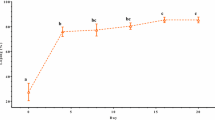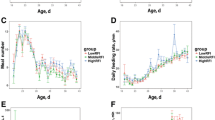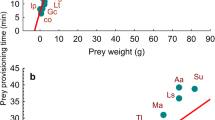Abstract
We examined the effect of an abrupt change in diet fibre content on the feed intake, gastrointestinal morphology and utilisation of gastroliths by a small (ca. 40 g body mass) herbivorous bird, the King Quail (Coturnix chinensis). King Quail were acclimated for 14 days on a low-fibre (LF) pullet starter diet. Following acclimation, half the quail population was immediately switched to a 23 % wood-shaving diluted high-fibre (HF) diet for a further 14 days. Contrary to expectations, we found no differences in feed intake, gut morphology or gastrolith mass between the LF- and HF-fed quail. However, when switched from the LF to HF diet, the quail commenced feed-sorting behaviours that permitted HF-fed animals to maintain body condition (mass, abdominal fat mass) without adjustments to intestinal organ sizes or gastrolith mass. Feed sorting was initiated only after exposure to the HF diet, which corresponded with an immediate reduction in food intake, suggesting that the sorting behaviour was cued by a physiological challenge associated with the HF diet. This challenge apparently induced preferential sorting behaviour and was possibly due to abrupt changes in the rate of food passage, impacting satiation or other internal cues.




Similar content being viewed by others
Abbreviations
- ADF:
-
Acid detergent fibre
- DMI:
-
Dry matter intake
- FI:
-
Feed intake
- EO:
-
Excreta output
- FP:
-
Feed provided
- FR:
-
Feed remaining
- FS:
-
Feed spilled
- HF:
-
High fibre
- LF:
-
Low fibre
- MET:
-
Metabolisability
- NDF:
-
Neutral detergent fibre
- OM:
-
Organic matter
- PLAT:
-
Plateau
- PRE:
-
Preliminary
- TRANS:
-
Transition
References
Ankney CD, Scott DM (1988) Size of digestive organs in breeding brown-headed cowbirds, Molothrus ater, relative to diet. Can J Zool 66:1254–1257. doi:10.1139/z88-183
Barboza PS, Parker KL, Hume ID (2009) Integrative wildlife nutrition. Springer-Verlag, Berlin
Beaune D, Le Bohec C, Lucas F, Cauthier-Clerc M, Le Maho Y (2009) Stomach stones in king penguin chicks. Polar Biol 32:593–597
Berteaux D, Crête M, Huot J, Maltais J, Ouellet J-P (1998) Food choice by white-tailed deer in relation to protein and energy content of the diet: a field experiment. Oecologia 115:84–92. doi:10.1007/s004420050494
Castelhano-Carlos MJ, Baumans W (2009) The impact of light, noise, cage cleaning and in-house transport on welfare and stress of laboratory rats. Lab Anim 43:311–327
Charmantier A, McCleery RH, Cole LR, Perrins C, Kruuk LEB, Sheldon BC (2008) Adaptive phenotypic plasticity in response to climate change in a wild bird population. Science 320:800–803. doi:10.1126/science.1157174
Dekinga A, Dietz MW, Am Koolhaas, Piersma T (2001) Time course and reversibility of changes in the gizzards of red knots alternately eating hard and soft food. J Exp Biol 204:2167–2173
Diamond J (1998) Evolution of biological safety factors: a cost/benefit analysis. Principles of animal design, the optimization and symmorphosis debate. Cambridge University Press, Cambridge, pp 21–35
Dietz MW, Dekinga A, Piersma T, Verhulst S (1999) Estimating organ size in small migrating shorebirds with ultrasonography: an intercalibration exercise. Physiol Biochem Zool 72:28–37
Fritz J, Kienzle E, Hummel J, Wings O, Streich WJ, Clauss M (2011) Gizzard vs. teeth, it’s a tie: food-processing efficiency in herbivorous birds and mammals and implications for dinosaur feeding strategies. Paleobiology 37:577–586. doi:10.1666/10031.1
Geluso K, Hayes JP (1999) Effects of dietary quality on basal metabolic rate and internal morphology of European starlings (Sturnus vulgaris). Physiol Biochem Zool 72:189–197
Gionfriddo JP, Best LB (1995) Grit use by house sparrows: effects of diet and grit size. Condor 97:57–67
Jamroz D, Jakobsen K, Orda J, Skorupinska J, Wiliczkiewicz A (2001) Development of the gastrointestinal tract and digestibility of dietary fibre and amino acids in young chickens, ducks and geese fed diets with high amounts of barley. Comp Biochem Physiol Part A Mol Integr Physiol 130:643–652. doi:10.1016/s1095-6433(01)00386-5
Kehoe FP, Ankney CD (1985) Variation in digestive organ size among five species of diving ducks (Aythya spp.). Can J Zool 63:2339–2342
Kehoe FP, Ankney CD, Alisauskas RT (1988) Effects of dietary fiber and diet diversity on digestive organs of captive mallards (Anas platyrhynchos). Can J Zool 66:1597–1602
Klasing KC (1998) Comparative avian nutrition. Cab International, Michigan
Klasing KC (2005) Poultry nutrition: a comparative approach. J Appl Poult Res 14:426–436
Krebs J (1977) Optimal foraging: theory and experiment. Nature 268:583–584
Lawrence CD (1981) Diet choice in small mammals. Ph.D. thesis, Indiana University
Levey DJ, Karasov WH (1992) Digestive modulation in a seasonal frugivore, the American robin (Turdus migratorius). Am J Physiol Gastrointest Liver Physiol 262:G711–G718
Luna RS, Duarte A, Weckerly FW (2013) Influence of body size on dietary nutrition of white-tailed deer Odocoileus virginianus. J Fish Wildl Manag 4:53–62
Matesanz S, Gianoli E, Valladares F (2010) Global change and the evolution of phenotypic plasticity in plants. Ann N Y Acad Sci 1206:35–55. doi:10.1111/j.1749-6632.2010.05704.x
May TA, Braun CE (1973) Gizzard stones from adult white-tailed ptarmigan (Lagopus Leucurus) in Colorado. Arct Alp Res 5:49–57
Miller MR (1975) Gut morphology of mallards in relation to diet-quality. J Wildl Manag 39:168–173
Moss R (1972) Effects of captivity on gut lengths in red grouse. J Wildl Manag 36:99–104
Moss R (1983) Gut size, body weight, and digestion of winter foods by grouse and ptarmigan. Condor 85:185–193
Munn AJ, Clissold F, Tarszisz E, Kimpton K, Dickman CR, Hume ID (2009) Hindgut plasticity in wallabies fed hay either unchopped or ground and pelleted: fiber is not the only factor. Physiol Biochem Zool 82:270–279
Norris E, Norris C, Steen JB (1975) Regulation and grinding ability of grit in the gizzard of Norwegian willow ptarmigan (Lagopus lagopus). Poult Sci 54:1839–1843
Olsson J, Quevedo M, Colson C, SvanbÄCk R (2007) Gut length plasticity in perch: into the bowels of resource polymorphisms. Biol J Linn Soc 90:517–523. doi:10.1111/j.1095-8312.2007.00742.x
Piersma T, Gill RE (1998) Guts don’t fly: small digestive organs in obese bar-tailed godwits. Auk 115:196–203
Piersma T, Lindström Å (1997) Rapid reversible changes in organ size as a component of adaptive behaviour. Trends Ecol Evol 12:134–138. doi:10.1016/s0169-5347(97)01003-3
Piersma T, Am Koolhaas, Dekinga A (1993) Interactions between stomach structure and diet choice in shorebirds. Auk 110:552–564
Robertson JB, Van Soest PJ (1981) The detergent system of analysis and its application to human foods. The analysis of dietary fibre in foods. Marcel Dekker, New York, p 123
Savory CJ, Gentle MJ (1976a) Changes in food intake and gut size in Japanese quail in response to manipulation of dietary fibre content. Br Poult Sci 17:571–580
Savory CJ, Gentle MJ (1976b) Effects of dietary dilution with fibre on the food intake and gut dimensions of Japanese quail. Br Poult Sci 17:561–570
Sherfy MH, Kirkpatrick RL, Webb KE Jr (2001) Nutritional consequences of gastrolith ingestion in blue-winged teal: a test of the hard-seed-for-grit hypothesis. J Wildl Manag 65:406–414
Starck JM (1996) Phenotypic plasticity, cellular dynamics, and epithelial turnover of the intestine of Japanese quail (Coturnix coturnix juponica). J Zool Lond 238:53–79
Starck JM (1999a) Phenotypic flexibility of the avian gizzard: rapid, reversible and repeated changes of organ size in response to changes in dietary fibre content. J Exp Biol 202:3171–3179
Starck JM (1999b) Structural flexibility of the gastro-intestinal tract of vertebrates—implications for evolutionary morphology. Zool Anz 238:87–101
Starck JM, Wang T (2005) Adaptive interplay between feeding ecology and features of the digestive tract in birds. Physiological and ecological adaptations to feeding in vertebrates. Science Publishers, Enfield, NH, USA, pp 201–228
Szczesna M, Zieba DA (2011) Role of leptin in the reproduction and metabolism: focus on regulation by seasonality in animals. Update of mechanisms of hormone action—focus on metabolism, growth and reproduction. In Technical report, pp 233–258
Van Soest PJ, Robertson JB, Lewis BA (1991) Methods for dietary fiber, neutral detergent fiber, and nonstarch polysaccharides in relation to animal nutrition. J Dairy Sci 74:3583–3597
Whitman DW, Agrawal AA (2009) What is phenotypic plasticity and why is it important? Phenotypic plasticity of insects: mechanisms and consequences. Science Publishers, Hauppauge, p 63
Williamson SA, Courtney-Jones SK, Munn AJ (2014) Is gastrointestinal plasticity in king quail (Cortunix chinensis) elicited by diet-fibre or diet-energy dilution? J Exp Biol (in press)
Wingfield JC, Maney DL, Breuner CW, Jacobs JD, Lynn S, Ramenofsky M, Richardson RD (1998) Ecological bases of hormone–behavior interactions: the “emergency life history stage”. Am Zool 38:191–206. doi:10.1093/icb/38.1.191
Wings O (2004) Identification, distribution, and function of gastroliths in dinosaurs and extant birds with emphasis on ostriches (Struthio camelus). Dissertation, Bonn University
Wings O (2007) A review of gastrolith function with implications for fossil vertebrates and a revised classification. Acta Palaeontol Pol 52:1–16
Wings O, Sander M (2007) No gastric mill in sauropod dinosaurs: new evidence from analysis of gastrolith mass and function in ostriches. Proc R Soc B Biol Sci 274:635–640
Withers PC, Cooper CE (2011) Using a priori contrasts for multivariate repeated-measures ANOVA to analyze thermoregulatory responses of the dibbler (Parantechinus apicalis; Marsupialia, Dasyuridae). Physiol Biochem Zool 84:514–521
Yearsley JM (2003) Optimal diet selection, frequency dependence and prey renewal. Theor Popul Biol 64:129–139
Acknowledgments
We are grateful to Stephanie Courtney Jones, James Lidsey and Alex Leslie for their assistance with dissections, to Prof. Kris French for assisting with statistics. A special thanks to Stanmore Veterinary Hospital for allowing and assisting us with radiology. All procedures were carried out in accordance with the University of Wollongong Animal Ethics Committee (protocol AE11/15), and in accordance with the Australian Code of Practice for the Care and Use of Animals for Scientific Purposes.
Author information
Authors and Affiliations
Corresponding author
Rights and permissions
About this article
Cite this article
Stewart, M., Munn, A.J. Fibre-induced feed sorting in King Quail (Coturnix chinensis): behavioural plasticity elicited by a physiological challenge. J Comp Physiol A 200, 789–797 (2014). https://doi.org/10.1007/s00359-014-0920-4
Received:
Revised:
Accepted:
Published:
Issue Date:
DOI: https://doi.org/10.1007/s00359-014-0920-4




